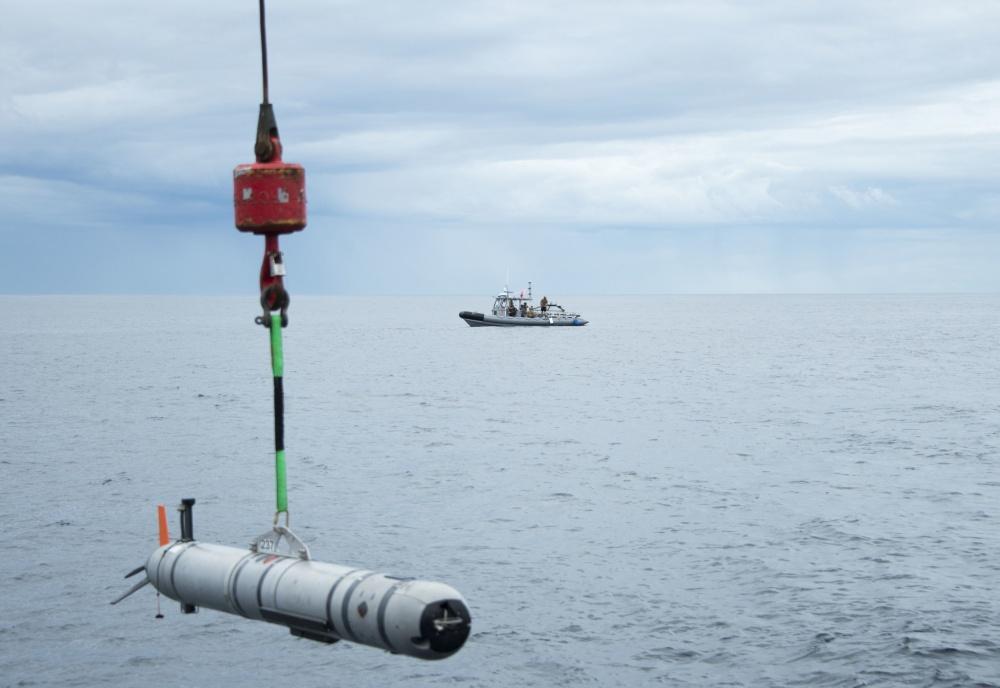Could unmanned underwater vehicles undermine nuclear deterrence?
Posted By Sylvia Mishra on May 8, 2019 @ 12:37

Nuclear deterrence rests on the ability of strategic assets to survive an enemy’s first strike and to retaliate, ensuring mutually assured destruction.
Nuclear-powered ballistic-missile submarines (SSBNs) are considered to be the most survivable of all nuclear platforms due to their stealth capabilities, mobility and discretion. Placing nuclear assets underwater puts them at a safer distance from a crippling first strike. But as technology improves and the ocean battlefield becomes more complex, these advances could undermine the survivability of strategic forces around the world and make them far more vulnerable.
Emerging technologies like unmanned underwater vehicles (UUVs) add to the complexity of the battle space and disrupt the status quo. Swarms of autonomous underwater drones could be deployed to hunt ballistic-missile submarines, targeting a cornerstone of nuclear deterrence.
In their 2017 article [1] ‘The new era of counterforce’, Keir A. Lieber and Daryl Press argue that for most of the nuclear age, the survivability of retaliatory forces seemed straightforward. However, improvements in counterforce technology have eroded this cornerstone of nuclear deterrence. As new technology continues to raise the potential for major shifts in the military realm, the rapid advent of these drones may reduce the credibility and effectiveness of SSBNs.
UUVs can function without the direction of a human operator and have wide dual-use (that is, civilian and military) applications [2]. Some are used for commercial purposes, hydrography and oceanographic research. Lockheed Martin’s yellow Marlin drone submarine inspects [3] offshore rigs and underwater pipelines, a task that’s worth around a billion dollars a year in the Gulf of Mexico.
But UUV technologies have been evolving from defensive to more offensive roles. UUVs increasingly play a critical role in antisubmarine warfare [4] (ASW) and perform missions such as placing and monitoring sensors on the sea floor to track enemy submarines. They can gather intelligence on opponents, detect and neutralise mines, hunt submarines and chart the ocean floor. They could, potentially, detonate warheads. And they could take part in a coordinated attack on an enemy submarine in conjunction with ‘friendly’ submarines and surface vessels.
The United States, Russia and China are investing in this technology to bolster their ASW capability and it’s evident that UUVs will be deployed in the near future in combat operations.
The US Navy released a UUV masterplan [5] in 2004 that set out nine priority areas for future UUV capabilities. In 2015, Brigadier General Frank Kelly became the first deputy assistant secretary of the US Navy for unmanned systems [6]. In 2016, the Department of Defense reportedly spent [7] US$232.9 million on procuring UUVs (US$86.7 million more than in 2015). In 2018, the US Office of Naval Research awarded Raytheon [8] a US$29.7 million contract for developing a naval prototype of a ‘low-cost UAV swarming technology’, or LOCUST, system that can overwhelm an adversary.
Russia and China aren’t far behind. Several reports [9] indicate that Russia has been working on a ‘killer underwater drone’ since 2015. The ‘Cephalopod’ is designed for the underwater battlefield. Undersea warfare expert H.I. Sutton says [9] that it can target shipping but its torpedoes are intended to destroy submarines. In a March 2018 speech to the Federal Assembly of the Russian Federation, President Vladimir Putin highlighted [10] Russian military development of an underwater drone aimed at transforming underwater warfare. A RAND Corporation report [11], Emerging trends in China’s development of unmanned systems, said Beijing had been funding 15 different universities for research programs for UUVs. Reports indicate [12] that China is also developing low-cost unmanned UUVs for a variety of military applications, including ‘suicide’ attacks on enemy vessels.
These trends indicate that the proliferation of UUVs will have an impact on the stability of the undersea warfighting domain. Emerging capabilities suggest that the sea-based leg of the triad of missile submarines, land-based intercontinental ballistic missiles and crewed bombers will increasingly become vulnerable.
However, some experts argue that underwater drone technology is still in a nascent stage of development and faces challenges in autonomous operations and communication. The density of seawater makes it difficult for UUVs to complete complex tasks that require real-time decision-making. Former Chief of US Naval Operations Admiral Jonathan Greenert noted [13] that one of the biggest obstacles for underwater drones is that they run on batteries that last only a few hours and communication is difficult because data passes very slowly through water.
It will take time for underwater drone technology to mature and pose a serious threat to well-hidden SSBNs, but when drones swarm in packs, it will become harder for submarines to escape detection. Advances in UUV technology will undermine the stability of deterrence and usher in a new underwater arms race that will increase the risks of escalation in a crisis.
As countries expand their underwater drone inventories, managing and controlling them could become challenging. It’s vital that operating nations develop a global code of conduct for their use.
Article printed from The Strategist: https://aspistrategist.ru
URL to article: /could-unmanned-underwater-vehicles-undermine-nuclear-deterrence/
URLs in this post:
[1] article: https://www.belfercenter.org/publication/new-era-counterforce-technological-change-and-future-nuclear-deterrence
[2] dual-use (that is, civilian and military) applications: https://www.simulyze.com/blog/from-land-to-sea-5-ways-drones-are-impacting-underwater-operations
[3] inspects: https://www.reuters.com/article/us-lockheed-marlin/weapons-maker-lockheed-builds-submarine-for-oil-rigs-idUSBRE87300D20120804
[4] critical role in antisubmarine warfare: https://www.csmonitor.com/USA/Military/2014/0716/Military-ramps-up-use-of-underwater-drones.-What-do-they-do
[5] UUV masterplan: https://www.navy.mil/navydata/technology/uuvmp.pdf
[6] first deputy assistant secretary of the US Navy for unmanned systems: https://news.usni.org/2015/10/27/retired-brig-gen-frank-kelley-named-first-ever-deputy-assistant-secretary-of-the-navy-for-unmanned-systems
[7] reportedly spent: http://www.kemplon.com/how-submarine-drones-are-changing-the-naval-modus-operandi/
[8] awarded Raytheon: https://navaltoday.com/2018/06/28/raytheon-wins-contract-for-locus-inp/
[9] reports: https://www.popularmechanics.com/military/navy-ships/a22593766/russia-working-on-new-cephalopod-underwater-attack-drone/
[10] highlighted: https://www.bbc.com/news/world-europe-43239331
[11] report: https://www.rand.org/pubs/research_reports/RR990.html
[12] indicate: https://www.scmp.com/news/china/society/article/2156361/china-developing-unmanned-ai-submarines-launch-new-era-sea-power
[13] noted: https://www.wsj.com/articles/underwater-drones-join-microphones-to-listen-for-chinese-nuclear-submarines-1414166607
Click here to print.